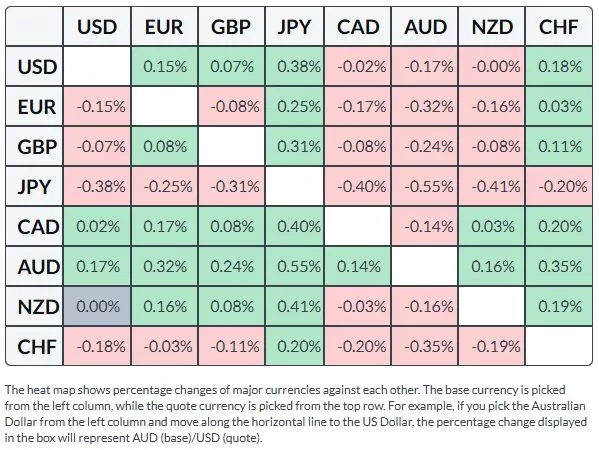Australian Dollar Recovers Losses On Optimism Surrounding US-China Trade Deal
Image Source: Unsplash
The Australian Dollar (AUD) gains ground against the US Dollar (USD) on Thursday after recovering from daily losses. However, the AUD/USD pair faced challenges as traders adopt caution ahead of the United States (US) inflation data for September due on Friday amid a data blackout.
The AUD received support after US President Donald Trump said that he thinks something will work out with China in a meeting scheduled with China's Xi Jinping in South Korea. Any shift in China’s economic conditions could also affect the Australian dollar (AUD), given the close trade ties between China and Australia.
The AUD/USD pair faces challenges amid growing bets of a near-term rate cut by the Reserve Bank of Australia (RBA). Australia’s latest employment report threw an unexpected curveball, with the jobless rate climbing to its highest level in nearly four years this September. The surprise spike jolted markets into upping the odds of a 25-basis-point rate cut to 70%, a sharp jump from roughly 40% just a week prior. Now, traders are on high alert, scouring the horizon for economic clues, from this week’s flash PMI readings to next week’s all-important Q3 CPI figures, in hopes of divining the central bank’s next move.
The AUD also draws support from improved market sentiment amid progress on a United States (US)-Australia trade agreement. President Trump and Australian Prime Minister Anthony Albanese signed a USD 8.5 billion critical minerals agreement at the White House on Monday, aimed at securing access to Australia’s abundant rare-earth resources amid China’s tighter export controls. Both nations also committed to investing at least USD 1 billion each over the next six months in mining and processing projects.
US Dollar gains as Trump expects agreements with China
- The US Dollar Index (DXY), which measures the value of the US Dollar (USD) against six major currencies, is gaining ground and trading around 99.00 at the time of writing. The Greenback received support from President Trump's comments late Wednesday that he expects to strike several agreements with Chinese President Xi Jinping during their meeting in South Korea next week. The Trump-Xi discussions are expected to cover a wide range of issues, including US soybean exports, limiting nuclear weapons, and China’s purchases of Russian Oil.
- The US Dollar may struggle as the prolonged US government shutdown delays the key US economic data releases, including Nonfarm Payrolls (NFP), adding uncertainty for financial markets and the Federal Reserve (Fed).
- The US government shutdown has entered its fourth week as the Senate on Monday failed for the 11th time to advance a House-passed measure to fund the government and end the ongoing shutdown. The 50-43 vote fell mostly along party lines. This marks the third-longest funding lapse in modern history.
- A Reuters poll suggested that 115 out of 117 economists have predicted that the Fed will reduce interest rates by 25 basis points (bps) to 3.75%-4.00% in the monetary policy announcement on October 29. For the year, 83 of 117 economists expect the US Federal Reserve to cut interest rates twice, while 32 anticipate one cut.
- The CME FedWatch Tool indicates that markets are now pricing in nearly a 97% chance of a Fed rate cut in October and a 96% possibility of another reduction in December.
- The People’s Bank of China (PBOC) decided on Monday to keep its one- and five-year Loan Prime Rates (LPRs) unchanged at 3.00% and 3.50%, respectively.
- China’s Gross Domestic Product (GDP) grew 4.8% year-over-year (YoY) in the third quarter (Q3) of 2025, as expected following a 5.2% growth in the second quarter. Meanwhile, the economy expanded 1.1% quarter-over-quarter (QoQ), surpassing the market consensus of 0.8% print.
- China’s annual June Retail Sales increased by 3.0% in September, against 2.9% expected and 3.4% prior, while Industrial Production came in at 6.5% vs. 5.0% estimate and August’s 5.2%.
Australian Dollar targets 0.6500 barrier near nine-day EMA
AUD/USD is trading around 0.6490 on Thursday. Technical analysis of a daily chart suggests a persistent bearish bias, with the pair trading within a descending channel. The 14-day RSI remains below 50, suggesting the bearish outlook is strengthening.
On the downside, the AUD/USD pair may navigate the area around the four-month low of 0.6414, followed by the lower boundary of the descending channel around 0.6400. A break below this confluence support zone would strengthen the bearish bias and prompt the pair to test the five-month low of 0.6372.
The AUD/USD pair is testing the immediate barrier at the psychological level of 0.6500, aligned with the nine-day Exponential Moving Average (EMA) of 0.6504. Further advances would improve the short-term price momentum and support the pair to test the 50-day EMA at 0.6541, followed by the descending channel’s upper boundary around 0.6560.
AUD/USD: Daily Chart

Australian Dollar Price Today
The table below shows the percentage change of Australian Dollar (AUD) against listed major currencies today. Australian Dollar was the strongest against the Japanese Yen.

More By This Author:
USD/CAD Falls To Near 1.4000 As Oil Prices Extend Gains On Falling StockpilesAustralian Dollar Receives Downward Pressure From Ongoing US-China Trade Tensions
WTI Holds Losses Near $58.00, Downside Seems Limited As India Halts Russian Oil Imports
Information on these pages contains forward-looking statements that involve risks and uncertainties. Markets and instruments profiled on this page are for informational purposes only and should not ...
more



